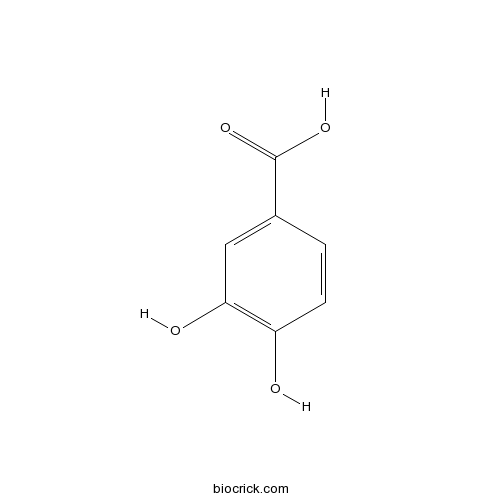Harrisonia perforata
Harrisonia perforata
1. The products in our compound library are selected from thousands of unique natural products; 2. It has the characteristics of diverse structure, diverse sources and wide coverage of activities; 3. Provide information on the activity of products from major journals, patents and research reports around the world, providing theoretical direction and research basis for further research and screening; 4. Free combination according to the type, source, target and disease of natural product; 5. The compound powder is placed in a covered tube and then discharged into a 10 x 10 cryostat; 6. Transport in ice pack or dry ice pack. Please store it at -20 °C as soon as possible after receiving the product, and use it as soon as possible after opening.
Natural products/compounds from Harrisonia perforata
- Cat.No. Product Name CAS Number COA
-
BCN4537
3,4-Dihydroxybenzoic acid99-50-3
Instructions

16-nor Limonoids from Harrisonia perforata as promising selective 11β-HSD1 inhibitors.[Pubmed: 27833136]
None
Antiplasmodial activities of a Thai traditional antipyretic formulation, Bencha-Loga-Wichian: A comparative study between the roots and their substitutes, the stems.[Pubmed: 27396349]
Bencha-Loga-Wichian (BLW) is a polyherbal antipyretic formulation that is comprised of Capparis micracantha, Clerodendrum indicum, Ficus racemosa, Harrisonia perforata, and Tiliacora triandra. A traditional medical textbook has documented the use of this formulation for the treatment of many types of fever, including malaria-like fever. Traditionally, BLW is composed of the root parts of those plants. However, in current practice, the stem parts are frequently substituted. Thus, this study aimed to evaluate the antiplasmodial activities of BLW and compare the efficacy between the stem and root parts.
Unprecedented Quassinoids with Promising Biological Activity from Harrisonia perforata.[Pubmed: 25810025]
Perforalactone A (1), a new 20S quassinoid with a unique cagelike 2,4-dioxaadamantane ring system and a migrated side chain, was isolated from the plant Harrisonia perforata together with two biosynthetically related new quassinoids. The structures of these natural products were elucidated by NMR spectroscopy, X-ray diffraction analysis, computational modeling, and the CD excitation chirality method. The compounds exhibited notable biological properties, including insecticidal activity against Aphis medicaginis Koch and antagonist activity at the nicotinic acetylcholine receptor of Drosophila melanogaster. The structural features of these compounds may be related to their promising biological characteristics. Their biosynthesis and an alternative origin of quassinoid-type natural products are also discussed.
Inhibitory Effect on β -Hexosaminidase Release from RBL-2H3 Cells of Extracts and Some Pure Constituents of Benchalokawichian, a Thai Herbal Remedy, Used for Allergic Disorders.[Pubmed: 25580152]
Benchalokawichian (BCW), a Thai traditional herbal formulation, has long been used as antipyretic and to treat skin disorders. It comprises roots from five herbs: Ficus racemosa, Capparis micracantha, Clerodendrum petasites, Harrisonia perforata, and Tiliacora triandra. This polyherbal remedy has recently been included in the Thailand National List of Essential Medicines (Herbal Products list).
[Study on the chemical constituents in the fruit of Harrisonia perforata].[Pubmed: 23901646]
To study the chemical constituents in the fruit of Harrisonia perforata.
Rearranged limonoids and chromones from Harrisonia perforata and their anti-inflammatory activity.[Pubmed: 23688954]
Two new rearranged limonoids, harperforatin (1) and harperfolide (2), and a new chromone, harperamone (3), were isolated from fruits and roots of Harrisonia perforata, together with eight known compounds. Their structures were elucidated on the basis of spectroscopic data. Harperfolide (2) exhibited potent anti-inflammatory activity by suppressing nitric oxide (NO) production from activated macrophages with IC50 value of 6.51 μM. Furthermore, its effect is mediated by reduction of iNOS protein expression, attributable to the inhibitory action of LPS-induced NO production.
HPLC analysis and cytotoxic activity of Vernonia cinerea.[Pubmed: 23156983]
The extracts of five Cambodian medicinal plants (Aganosma marginata, Dracaena cambodiana, Harrisonia perforata, Hymenodictyon excelsum and Vernonia cinerea) were evaluated in vitro for their cytotoxic activity against HT29 colon adenocarcinoma cells and HepG2 hepatoma cells, using the MTT assay. Among these five plants, Vernonia cinerea displayed potent cytotoxicity. One main sesquiterpene lactone, 8alpha-tigloyloxy-hirsutinolide-13-O-acetate was isolated from the whole plant of V. cinerea. This compound was active against both cancer cell lines (IC50 = 3.50 microM for HT29 and IC50 = 4.27 microM for HepG2). To quantify this compound in the plant, an analytical high-performance liquid chromatography (HPLC) method was developed and validated.
Chemical constituents from fruits of Harrisonia perforata.[Pubmed: 21315383]
Eight limonoids (1-8) including three A, B and D-seco-16-nor-type ones, 5,6-dehydrodesepoxyharperforin C2 (1), harrpernoid B (2), and its C-9S epimer, harrpernoid C (3), along with six known compounds (9-14), were isolated from fruits of Harrisonia perforata. Extensive spectroscopic analysis was used to elucidate their structures and stereochemistries. Further confirmation of structures of 1 and 2 were obtained by single-crystal X-ray diffraction. Limonoids (1-8) were evaluated for their anti-tobacco mosaic virus activity and in vitro cytotoxicity against A549 and HL60 cell lines; only compound 2 showed weak activity.


